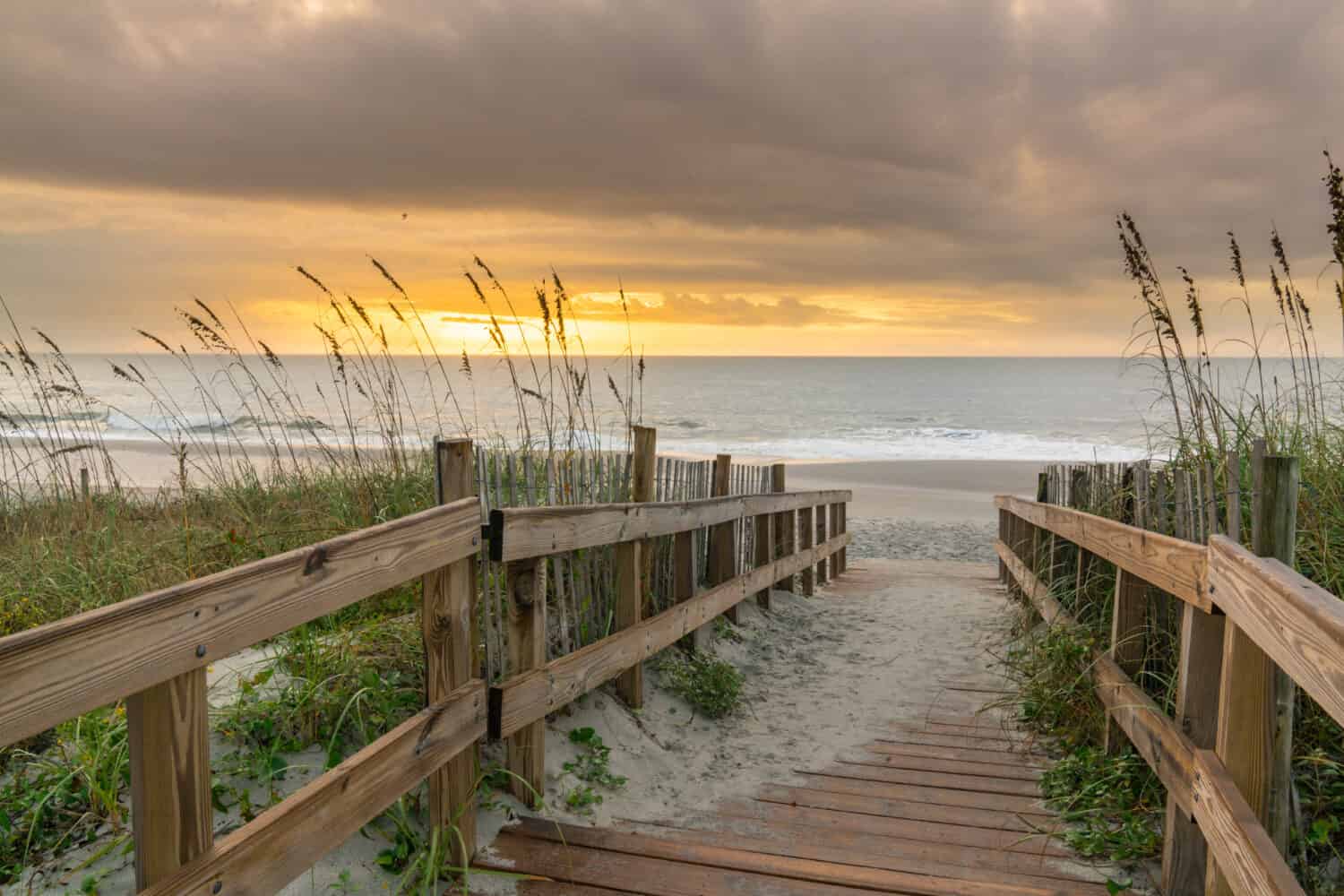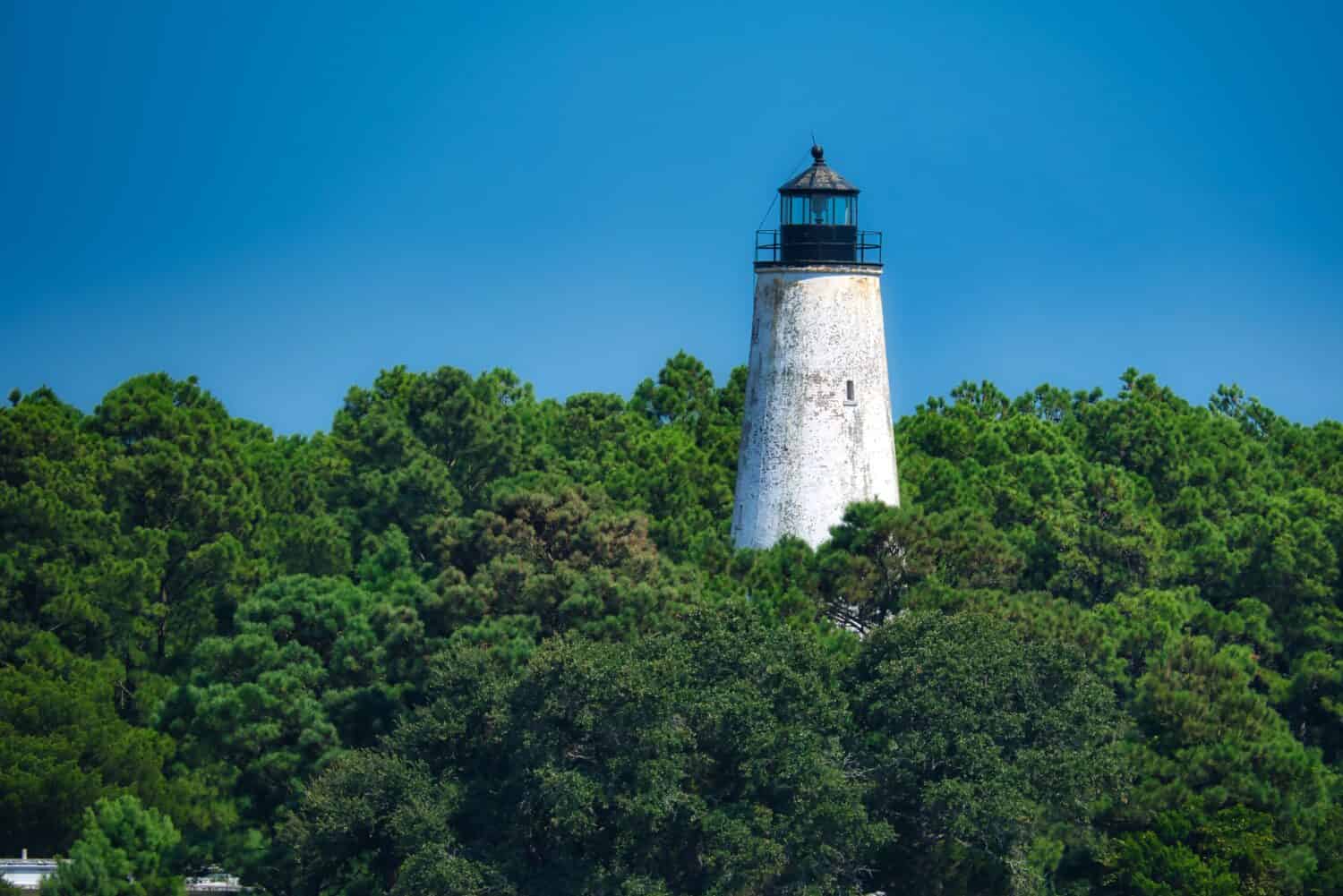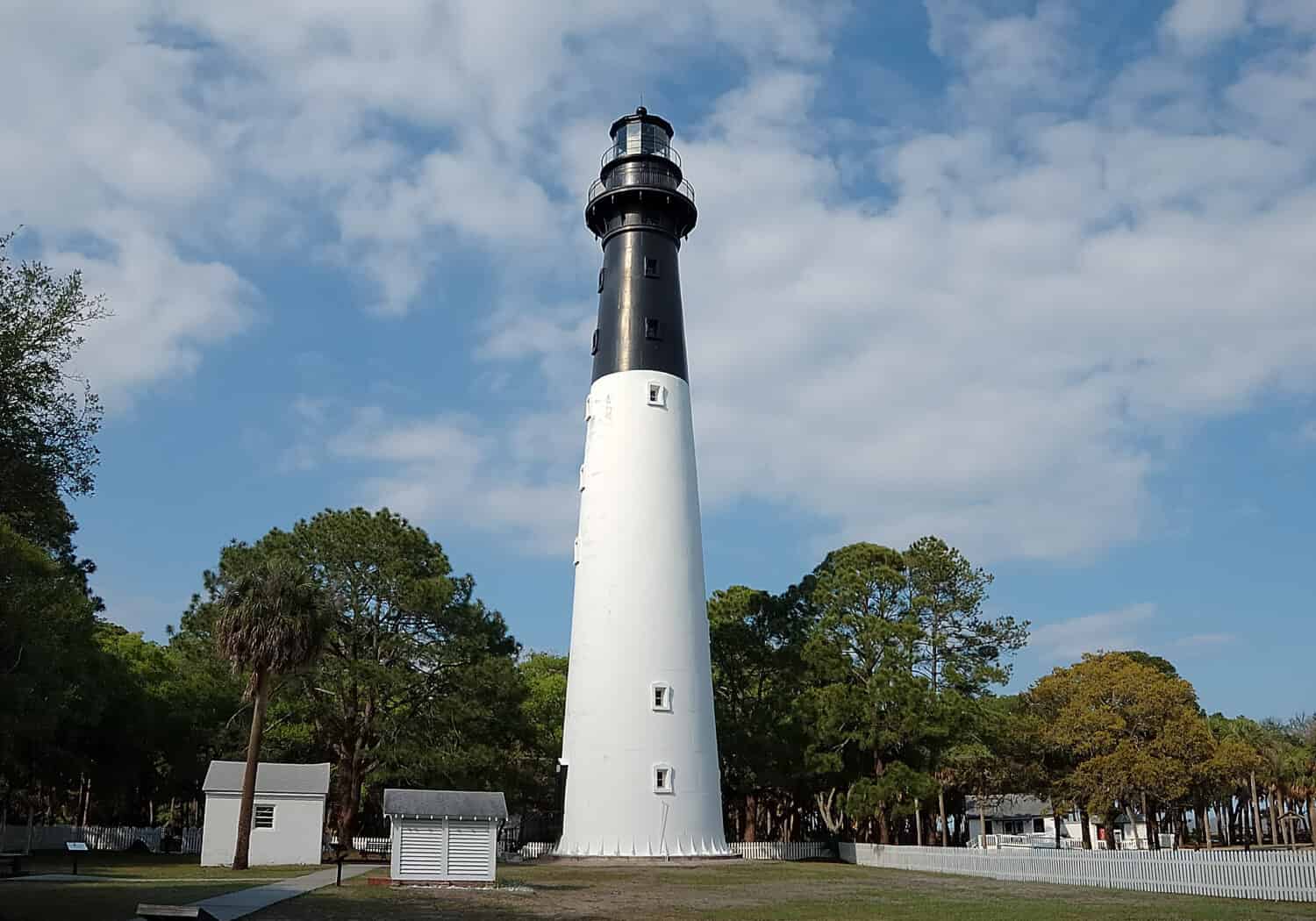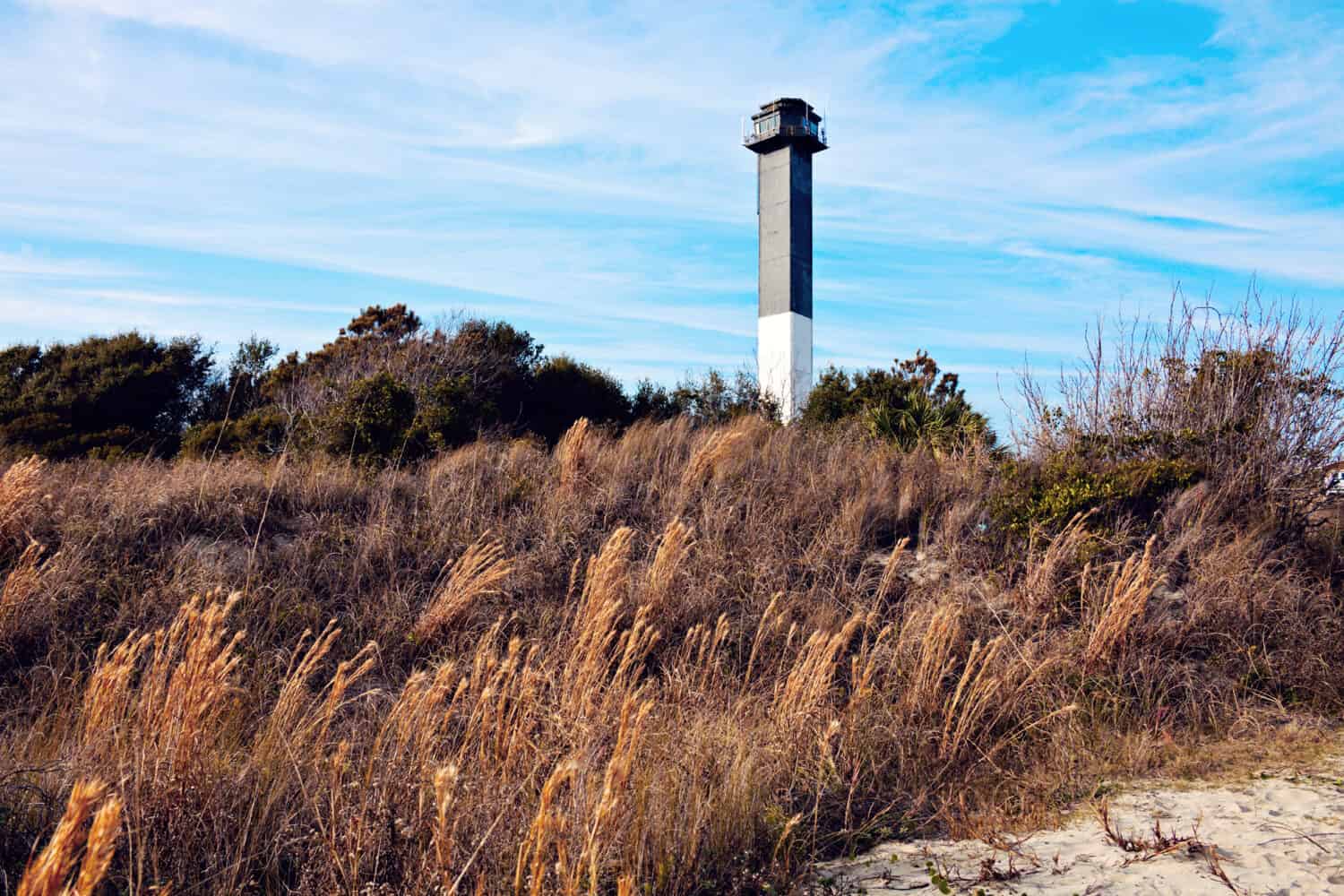South Carolina is a U.S. state particularly well known for its islands, beaches, and coastline. It is the 23rd most populated state in the country and home to many American industries such as car manufacturing, agriculture, and aerospace. South Carolina is also the location of many historical lighthouses, including some from as far back as the 1700s!
Read on to discover which of these lighthouses to visit should you plan a trip to South Carolina.

A boardwalk on the coastline of South Carolina.
©Paul Brady Photography/Shutterstock.com
Georgetown Lighthouse
Construction on the Georgetown Lighthouse (also known colloquially as the North Island Light) began in 1801. It is the oldest lighthouse in South Carolina and the last to dismiss its staff before automation.
From 1795 to 1798, a budget of $7000 was provided to build a lighthouse that would help ships carrying goods for trade pass safely between the North and South Islands off the coast. The land it was to be built on was donated in 1789 but it would be more than a decade before construction began.
In 1801 a wooden tower totaling seventy-two feet in height was completed, along with a two-story keeper’s quarters. Unfortunately, a massive storm destroyed both structures within five years. United States Congress then budgeted another $20,000 to build up the grounds again. The new lighthouse was made primarily from brick and stone, reinforcing it against high-speed wind and rain.

The Georgetown Island Lighthouse peeks out from amongst the trees.
©Joe Herlong/Shutterstock.com
It was completed for a second time in 1811 and the Georgetown Lighthouse ran for nearly four decades before being upgraded again. In 1854 a fourth-order Fresnel lens was installed, strengthening the brightness and length of the beam.
During the American Civil War, Confederate soldiers commandeered the grounds, turning it into a lookout station. By May of 1862, the Union army acquired the Georgetown Lighthouse, but the tower and keeper’s quarters were significantly damaged by the war. During repairs, the tower was elongated to eighty-seven feet tall, and in 1867 a fourth-order Fresnel lens was provided. In 1986 the light was automated and the staff let go from their positions.
Today, the land around the Georgetown Lighthouse has been converted into a wildlife preserve. While the tower itself is not open to tourists, there are two companies that provide boat tours to the island – Rover Tours and Cap’n Rod’s Low Country Boat Tours.
Haig Point Lighthouse
The Haig Point Lighthouse was built in 1872, to help escort passing ships through the Calibogue Sound. It was built, with the addition of two Daufuskie Island range lights, to replace the Calibogue Sound Lightship as a navigation aid.
The tower stood forty feet tall, with a wooden two-story lighthouse keeper’s quarters also erected for a small staff. On August 29, 1873, construction was completed and the first lighthouse keeper was installed. By October 1st the station was ready to help ships enter the Calibogue Sound safely. It also provided a consistent light for those traveling between the Savannah River and Port Royal Harbor.

A fifth-order Fresnel lens was installed in the Haig Point Lighthouse. Over the next decade a dock, ramp, and boathouse were built to increase the functionality of the station. The tower was damaged in an 1886 earthquake but was soon repaired.
The first lighthouse keeper, Patrick Comer, served until 1891 when he died in his bed on-site. The Haig Point Lighthouse only had a total of three keepers, including Richard Stonebridge (who served from 1891 until 1923) and Charles L. Sisson (whose tenure lasted only a year.)
The United States Coast Guard decommissioned the Haig Point Lighthouse in July of 1924. The following year it was sold to a private citizen for $1,499.99. Over the ensuing years, it was sold to multiple owners (and at one time used as a hunting lodge) until it was bought by George H. Bostwick in 1961. Bostwick set about restoring the lighthouse, and renovations were completed by the International Paper Realty Corporation who bought the property in 1984.
Today the Haig Point Lighthouse operates similarly to a private club, open for guests of the community with four luxury suites, two lighthouse bedrooms, and event spaces for weddings and parties.
Hunting Island Lighthouse
The Hunting Island Lighthouse was built in 1859 to help ships move between Savannah and Charleton. It was also useful for those traveling from St. Helena Sounds and Port Royal and vice versa.
The construction of the lighthouse was kickstarted by an 1853 petition for navigational aid in the area. In response, United States Congress provided $30,000 on August 3rd, 1854, and the tower was built and functioning by July 1st of 1859.
The Hunting Island Lighthouse stood 95 feet tall and was made largely from brick. A second-order Fresnel lens helped the tower’s beacon extend 17 miles out to sea. In 1861, during the American Civil War, the original tower was decimated by the Confederate Army in order to slow the arrival of Union troops approaching Port Royal.

The Hunting Island Lighthouse, with a distinctive black and white daymark.
©paladin/Shutterstock.com
On June 10th, 1872, Congress approved a budget of $30,000 to build a new lighthouse, with an extra $50,000 provided to make it relocatable in case of erosion. The second lighthouse was completed by June 1875 and stood one-hundred-twenty-one feet tall with a concrete base. A second-order Fresnel lens was also installed, as well as a twelve-room, two-story keepers quarters.
In 1889 the lighthouse was moved a mile and a half inland in response to the approaching coastline. By 1933, the lighthouse was decommissioned and the United States Senate passed the property on to Beaufort County. It was then bought by the state of South Carolina which turned Hunting Island into a state park.
The Hunting Island Lighthouse is one of only eight towers that have survived to the present day in South Carolina. It is the only lighthouse consistently available to the public in the entire state. It is open to visitors from 6am to 6pm every day, with admission free to children five years of age and younger.
Charleston Lighthouse
The Charleston Lighthouse (also known as the Sullivan’s Island Lighthouse) is distinguished as one of the most state-of-the-art lighthouses in the country. In many ways, it resembles a piece of modern art more than it does a traditional tower. It is also one of the final lighthouses to be commissioned by the United States government.
Construction on the Charleston Lighthouse started in 1960 and was finished within two years. It was built to replace the long-standing Morris Island Lighthouse after encroaching erosion began to threaten its stability.

Charleston lighthouse located on Sullivan’s Island in South Carolina.
©Henryk Sadura/Shutterstock.com
The Charleston Lighthouse was first lit in the summer of 1962 and (at the time) emitted the second-brightest light west of the Prime Meridian. The intensity of this light meant that anyone entering the lantern room had to wear a full-body welding suit. It was replaced a few years later largely due to these complicating factors. Today, the beam can be seen twenty-seven miles off the coastline.
The Charleston Lighthouse stands one-hundred-forty feet tall, helping guide vessels across the Atlantic Ocean and into southeastern America’s most active harbors. The inclusion of both an elevator and air-conditioning make it one of the most convenient lighthouses in the country to preserve and repair.
The triangular shape of the lighthouse helps it to survive hurricane-level winds of up to one-hundred-twenty-five miles an hour. The United States Coast Guard yielded ownership of the Charleston Lighthouse to the National Park Service in 2008. While the inside is not currently accessible for visitors, the grounds are open during daylight hours.
Harbour Town Lighthouse
The Harbour Town Lighthouse (also known as “Fraser’s Folly”) is unique in its origin. Most lighthouses are the result of official petitions or federal government directives. This lighthouse, however, was bankrolled by a private citizen – Charles Fraser.
Fraser is one of the founders of the eco-friendly Sea Pines Resort, and he personally commissioned the lighthouse to add a characteristic landmark to distinguish Hilton Head Island. Construction on the Harbour Town Lighthouse began in 1969 and was completed just one year later on a budget of $68,000.

A clear blue sky features the Harbour Town Lighthouse – a famous landmark in Hilton Head, SC.
©Denise Kappa/Shutterstock.com
The tower stands ninety-three feet tall and provides a picturesque view of the surrounding marina. Locals were initially dubious of the prospect of Fraser’s project, hence the nickname “Fraser’s Folly.” As the decades passed, the lighthouse became a treasured part of the island and its history.
Climbing the one-hundred-fourteen steps to the top also serves as a self-guided tour. Multiple photos, documents, and artifacts adorn the walls, offering a history of life on the island from its earliest native population up to the present day.
The lighthouse was refurbished on a budget of $200,000 from 2001 to 2002. The public now pays an admission fee to visit the lighthouse to help recoup costs. While the Harbour Town Lighthouse was not created solely for navigational purposes, it is included in maps and emits a beam that can be seen fifteen miles away.
The photo featured at the top of this post is ©
Thank you for reading! Have some feedback for us? Contact the AZ Animals editorial team.







